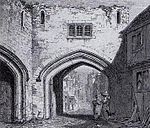Royal Aquarium
1876 establishments in England1907 disestablishments in EnglandBuildings and structures demolished in 1903Cultural infrastructure completed in 1876Event venues established in 1876 ... and 4 more
Former buildings and structures in the City of WestminsterFormer music hall venues in the United KingdomFormer theatres in LondonUse British English from May 2015

The Royal Aquarium and Winter Garden was a place of amusement in Westminster, London. It opened in 1876, and the building was demolished in 1903. The attraction was located northwest of Westminster Abbey on Tothill Street. The building was designed by Alfred Bedborough in an ornamental style faced with Portland stone. The Aquarium Theatre was located in the west end of the building and was renamed the Imperial Theatre in 1879. Methodist Central Hall now occupies the site.
Excerpt from the Wikipedia article Royal Aquarium (License: CC BY-SA 3.0, Authors, Images).Royal Aquarium
Storey's Gate, City of Westminster Millbank
Geographical coordinates (GPS) Address Nearby Places Show on map
Geographical coordinates (GPS)
| Latitude | Longitude |
|---|---|
| N 51.5 ° | E -0.13 ° |
Address
Methodist Central Hall
Storey's Gate
SW1P 3AT City of Westminster, Millbank
England, United Kingdom
Open on Google Maps








